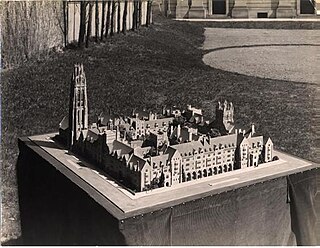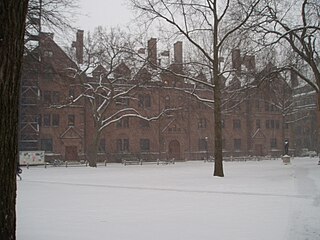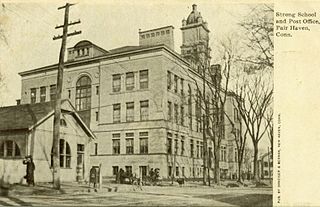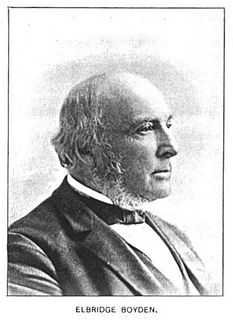
Branford Center is a neighborhood and census-designated place (CDP) in the town of Branford, Connecticut, United States. The CDP encompasses the traditional town center area and the area known as Branford Point. The population of the CDP was 5,819 at the 2010 census.

Ithiel Town was a prominent American architect and civil engineer. One of the first generation of professional architects in the United States, Town made significant contributions to American architecture in the first half of the 19th century. His work, in the Federal and revivalist Greek and Gothic revival architectural styles, was influential and widely copied.

The New Haven Green is a 16-acre (65,000 m2) privately owned park and recreation area located in the downtown district of the city of New Haven, Connecticut. It comprises the central square of the nine-square settlement plan of the original Puritan colonists in New Haven, and was designed and surveyed by colonist John Brockett. Today the Green is bordered by the modern paved roads of College, Chapel, Church, and Elm streets. Temple Street bisects the Green into upper (northwest) and lower (southeast) halves.

New Haven Coliseum was a sports and entertainment arena located in downtown New Haven, Connecticut. Construction began in 1968 and was completed in 1972. The Coliseum was officially closed on September 1, 2002, by Mayor John DeStefano Jr., and demolished by implosion on January 20, 2007.
Long Wharf is a waterfront district and neighborhood of the city of New Haven, Connecticut, United States.

The Memorial Quadrangle is a residential quadrangle at Yale University in New Haven, Connecticut. Commissioned in 1917 to supply much-needed student housing for Yale College, it was Yale's first Collegiate Gothic building and its first project by James Gamble Rogers, who later designed ten other major buildings for the university. The Quadrangle has been occupied by Saybrook College and Branford College, two of the original ten residential colleges at Yale. The collegiate system of Yale University was largely inspired by the Oxbridge model of residential and teaching colleges at the University of Oxford and the University of Cambridge in the UK.

The Old Campus is the oldest area of the Yale University campus in New Haven, Connecticut. It is the principal residence of Yale College freshmen and also contains offices for the academic departments of Classics, English, History, Comparative Literature, and Philosophy. Fourteen buildings—including eight dormitories and two chapels—surround a 4-acre (1.6 ha) courtyard with a main entrance from the New Haven Green known as Phelps Gate.
Fair Haven Heights, or simply the Heights, is a residential and light industrial neighborhood in the eastern part of the city of New Haven, Connecticut, located east of the Quinnipiac River. Fair Haven Heights is not to be confused with the adjacent Fair Haven neighborhood west of the river. The area is bordered on the west by the Quinnipiac River, on the north by Route 80, on the east by the town of East Haven, and on the south by Ferry Street and Warwick Avenue. The main through routes are Quinnipiac Avenue, East Grand Avenue, and Eastern Street
The Universalist Church of West Hartford is a Unitarian Universalist congregation in West Hartford, Connecticut.

The Osborn Memorial Laboratories in New Haven, Connecticut were built in 1913 as the home for biology at Yale University. In the past, they contained both zoology and botany, in the two wings on Sachem Street and Prospect Street. They sit at the base of Sachem's Woods: the original site of Highwood, the mansion of James Abraham Hillhouse. This area is now known as Science Hill and is the site of Kline Biology Tower, Sage Hall, and chemistry and physics buildings. The building sits across Prospect Street from Ingalls Rink and across Sachem from the Yale School of Management. It was designed by the architect Charles C. Haight, who also designed buildings of the original Columbia University campus on the current site of Rockefeller Center.
The Pitkin Tunnel or Pitkin Street Tunnel is a below-ground-level, roofed but not entirely enclosed roadway, in downtown New Haven, Connecticut, United States. It accommodates simultaneous motor vehicle traffic in both directions. The tunnel runs from the eastbound one-way Elm Street between Church and Orange Streets, with the southbound lanes of State Street between Court and Chapel Streets across from State Street station. It passes under Orange Street. It runs under or next to the New Haven City Hall and County Courthouse and the Federal Courthouse on Church Street, the local Emergency Operations Center, and at least three more buildings that house banks and the headquarters of United Illuminating, the electric utility serving much of New Haven and Fairfield counties.

Harmanus Welch Hall is a freshman dormitory at Yale University in New Haven, Connecticut, United States. The building is located on Yale University's Old Campus. Pierce N. Welch, an 1862 graduate of Yale College, Mrs. Cora Van Milligan, and Mrs. Grace M. Davies, heirs of Harmanus M. Welch, mayor of New Haven from 1860 to 1863, donated the building to Yale in 1891 in accordance with their father's wishes. The architect Bruce Price designed the building.
The Chapel Square Mall was a shopping mall in downtown New Haven, Connecticut. It was one of the first fully enclosed air-conditioned downtown malls in the United States; it has now been converted into apartments.

Sterling Law Building houses the Yale Law School. It is located at 127 Wall Street, New Haven, Connecticut, close to the downtown area, in the heart of the Yale campus. It occupies one city block between the Hall of Graduate Studies, the Beinecke Library, Sterling Library, and the Grove Street Cemetery.

Cedar Hill is a neighborhood in New Haven, Connecticut. It includes portions of the city-designated neighborhoods of East Rock, Quinnipiac Meadows, and Mill River. Cedar Hill was named for cedar trees that were once plentiful there in 1665. The area was divided from the local surroundings by the construction of I-91 in the 1960s. Cedar Hill's boundary runs from James Street, up the Mill River, to Rice Field, over Indian Head Rock, to the Hamden town line, across to Middletown Avenue, to the Eastern side of State Street, back up to James Street.

Prospect Hill is a neighborhood of the city of New Haven, Connecticut located in the north central portion of the city, directly north of Downtown New Haven. The neighborhood contains residences, institutional buildings of Albertus Magnus University and a portion of the main campus of Yale University, including the Science Hill area, the Hillhouse Avenue area and the Yale Peabody Museum. The City of New Haven defines the neighborhood to be the region bounded by the town of Hamden in the north, Winchester Avenue in the west, Munson Street/Hillside Place/Prospect Street in the southwest, Trumbull Street in the south, and Whitney Avenue in the east. Prospect Street is the main thoroughfare through the neighborhood.
Troyon's Raid occurred in July 1779, during the American Revolutionary War, in which 2700 men, led by British Major General William Tryon, raided the Connecticut ports of New Haven, Fairfield, and Norwalk. They destroyed military and public stores, supply houses, and ships as well as private homes, churches, and other public buildings. The raids were ineffectually resisted by militia forces.

Strong School is a school located at 69 Grand Ave. in the Fair Haven neighborhood of New Haven, Connecticut, USA. It is an overflow school for district kindergartners and first graders. It has a student population of approximately 277 utilizing a 1.055-acre (4,270 m2) site.

Elbridge Boyden (1810–1898) was a prominent 19th-century American architect from Worcester, Massachusetts who designed numerous civil and public buildings throughout New England and other parts of the United States. Perhaps his best known works are the Taunton State Hospital (1851) and Mechanics Hall (1855) in Worcester.

The Downtown Waterbury Historic District is the core of the city of Waterbury, Connecticut, United States. It is a roughly rectangular area centered on West Main Street and Waterbury Green, the remnant of the original town commons, which has been called "one of the most attractive downtown parks in New England."















